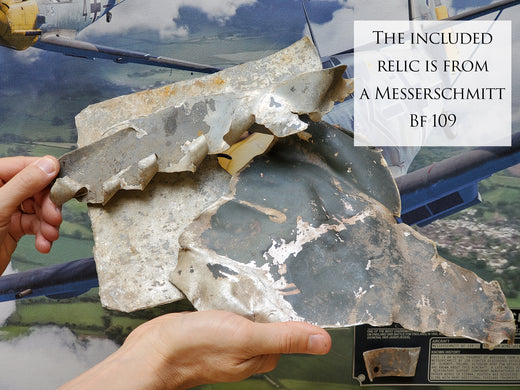This Fine Art Print by Artist Craig Tinder depicts Luftwaffe Ace, Werner Mölders and his wingman searching for new targets over the Eastern Front.
 Bf 109 - Werner Molders
Bf 109 - Werner Molders
Details About the RELIC:
This aluminum skin relic was recovered near the town of Gumrak, Russia, close to the Volgograd (formerly Stalingrad) airport. Likely originating from a Messerschmitt Bf 109, possibly an F-4 or G-2 variant, this aircraft part connects directly to the fierce air battles during the Battle of Stalingrad in 1942-1943. Found near the Pitomnik and Gumrak airfields, the relic sheds light on the role of German aircraft during one of the most pivotal engagements of World War II.
 Messerschmitt Bf 109 aluminum skin fragment with RLM 70 and RLM 74 paint colors
Messerschmitt Bf 109 aluminum skin fragment with RLM 70 and RLM 74 paint colors
At the time, Gumrak and Pitomnik airfields were critical supply and support bases for the encircled 6th Army, trapped by Soviet forces in the infamous Stalingrad pocket. The German command heavily relied on these airfields to supply the encircled 6th Army, with Tatsinskaya and Morozovsk serving as main supply bases, while smaller airstrips like Voroponovo and Basargino supported transport and fighter operations.Luftwaffe fighters like the Bf 109 were tasked with providing air cover, engaging Soviet aircraft, and protecting German supply lines.
The Story Behind the Print:
Werner Mölders is widely regarded as one of the most influential fighter aces and tacticians of World War II. Born in 1913, Mölders quickly made his mark in aerial combat during the Spanish Civil War, where he honed his skills and became a formidable pilot. It was in World War II, however, that Mölders rose to legendary status. In June 1941, Mölders became the first pilot in history to achieve 100 aerial victories, a milestone that solidified his reputation as a groundbreaking figure in the Luftwaffe.
 Luftwaffe Pilot - Werner Mölders
Luftwaffe Pilot - Werner Mölders
Mölders' approach to aerial combat was revolutionary. He developed tactical doctrines that redefined dogfighting and squadron coordination for the Luftwaffe. Among his most notable contributions was the finger-four formation, which enhanced the maneuverability and flexibility of fighter units. This tactic, which involved four planes flying in a loose, finger-like pattern, allowed pilots to cover each other while remaining agile in combat. This formation, along with other strategies devised by Mölders, became the foundation for modern aerial warfare tactics and remains influential in air forces worldwide today.
In 1941, Mölders was promoted to Inspector of General Fighters, making him responsible for overseeing the Luftwaffe’s fighter forces. His promotion marked his growing influence not just as a fighter ace, but as a strategic mind shaping the future of aerial combat. Tragically, Mölders' career was cut short later that year when he died in a flying accident on 22 November 1941. He was en route to attend the funeral of World War I flying ace, Ernst Udet, when his aircraft crashed during bad weather. Mölders was only 28 years old at the time of his death, yet his legacy as a pilot and tactician continues to endure.
Learn more about A Comprehensive Study from the Battle of Britain to the Eastern Front and the Mediterranean for the Bf 109 in Different Theaters, Click Here
To purchase or see similar items, visit here.
Commissioned by Museums, Treasured by Collectors





Share:
The Whole Nine Yards
Escorted to Safety, the story behind "Homeward Bound"